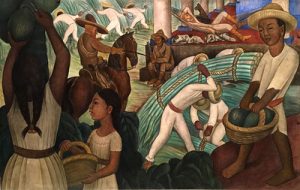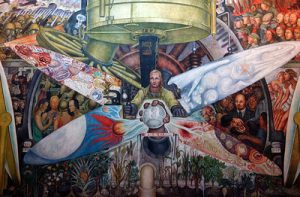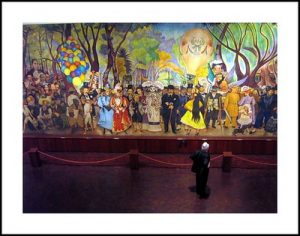Rebekah LaBoy: Diego Rivera: Latin American Muralist
My name is Rebekah LaBoy and the title of my work is: Diego Rivera: Latin American Muralist. CC BY 4.0.
Introduction
Diego Rivera was one of the most famous Mexican Muralists whose work has been an influential guide in modern art and Latin American art. Heavily influenced by the Mexican Revolution, Rivera’s art works seem to share socially conscious elements. One can see that many of his art shares stories of the indigenous Mexicans who were affected by colonization and neocolonialism.
Themes
The two themes that this portfolio project will be addressing for the decolonial artist, Diego Rivera are: the historical elements of these three works as well as political and social elements of his murals.

Analysis: Sugar Cane
This mural was produced in 1931. The prompting for this production was for historical reference of the colonization of Mexico by the Spanish and the struggles which the Mexicans faced. Highlighted is the laboring of the sugarcane crops, which was an extremely intense manual labor process. Also, sugarcane was a very important crop in Mexico. Rivera showcases the different racial classes in this mural. One can see that the Mexicans in this particular image are represented as the laborers. The men in the back far left are cutting down the sugarcane crops and the two men in the mid front are carrying sugarcane on their backs. With these two elements, the audience can get a feeling of the harsh manual labor that was endured. Rivera also pays homage to the indigenous with the image at the very front of the mural with an indigenous mother and her two children who are picking papaya fruit. However, the audience can also see the colonial presence with the guards in uniform centered in the mural and also with the plantation owner who is casually laying back in his hammock as the Mexicans work tirelessly. This is a socially and politically relevant mural as it highlights the historical truths of the colonization of Mexico and how the people were oppressed.

Analysis: Man Controller of the Universe
Diego Rivera produced this mural in 1934 in Mexico City, however, interestingly enough this was the second production of this piece. Rivera was originally commissioned and paid in full by the Rockefeller’s to produce this in the United States but because Rivera included an image of the communist Vladimir Lenin and refused to change it, the piece was destroyed. During this period of time there are a lot of historical things happening in the world. This was produced after the Mexican Revolution where Mexicans were trying to get away from the colonial past, the world is in economic crisis with the great depression, and there is immense unemployment. Rivera creates this socially and politically charged work of art where he is addressing the future of the world that “man” controls. There are so many intricate details to this multi leveled fresco. Some of these include the idea that we as humans have developed scientifically with understanding of the large span of the universe and also at the smallest bacterial level; this we can see in the direct middle of the portrait in an “X” or winged image behind the man controlling the operation. There are also symbols of war, communism, two classical figures, which are both broken, but almost in a way where Rivera is saying that these elements are broken and no longer relevant. Then he has series of different types and groups of people; the wealthy, including Rockefeller who out of anger he put in this fresco and even images of a group of diverse people who are learning. He was interested in bridging all these groups together and creating hope for the world.

Analysis:
Dream of a Sunday Afternoon in Alameda Central Park
The mural, Dream of a Sunday Afternoon in Alameda Central Park, was produced in 1947. This piece is packed with so many elements that span over 400 years of the history of Mexico. Uniquely and carefully designed by Rivera, he achieves a historical story within this work. Many famous Mexican figures are included in this work, both key loved figures and also hated figures. On the left of this image is the story of Mexican colonization and conquest. Towards the middle of this mural is the revolution of Mexico and the cost of independence and freedom. The right of the mural is a presentation of Mexican achievements in modern times. In the central of the composition is the rich bourgeois who are in their beautiful clothes and also notable is an image of the Mexican dictator, Porfirio Diaz who was in power when the Mexican Revolution started, he was exiled. This historical account from colonization and oppression to freedom and achievements creates a sense of national pride. I believe that socially politically it allows the audience to understand the Latin American experience and how they have overcome so many obstacles.
Application
Rivera was known for making art for the people, art that was meaningful to the public and he produced it in places where the people had access to view it such as government buildings. After the Mexican Revolution it was important for Muralist artists, including Diego Rivera to relate their works to common everyday things and parts of life that the audience could relate to. His art influenced artists in the United States. For instance, during El Movimiento in the 1960’s Civil Rights movements, artists responded during this time to paint murals on buildings in their neighborhoods to communicate the social and political desires and needs.
Diego Rivera is an important Latin American decolonial modern artist who uses conscious elements to communicate the past of colonization but also the hope of the world if we could come together.
Works Cited
“Painting a Movement: The Impacts of Diego Rivera’s Murals During and After the Mexican Revolution.” WordPress, 4 May 2020, cowlatinamerica.voices.wooster.edu/2020/05/04/painting-a-movement-the-impacts-of-diego-riveras-murals-during-and-after-the-mexican-revolution.
Bravo, Doris Maria-Reina. “Diego Rivera, Dream of a Sunday Afternoon in Alameda Central Park – Smarthistory.” Smart History, smarthistory.org/rivera-dream-of-a-sunday-afternoon-in-alameda-central-park. Accessed 29 Apr. 2022.
Quito, Anne. Cnn. “The Mexican Muralists Who Shaped Modern American Art.” CNN, CNN, 17 Jan. 2020, edition.cnn.com/style/article/mexican-muralists-whitney-museum-vida-americana-exhibition/index.html.
DiLiberto, Stacey. “UCF Federated Identity.” UCF, https://webcourses.ucf.edu/courses/1394173/pages/latino-visual-arts-and-chicano-slash-a-slash-x-art?module_item_id=15192438. Accessed 29 Apr. 2022.
Harris, Beth and Zucker, Steven. “Diego Rivera, Man Controller of the Universe,” in Smarthistory, April 4, 2016, accessed April 29, 2022, https://smarthistory.org/diego-rivera-man-controller-of-the-universe/.
Affron, Matthew and Zucker, Steven. “Diego Rivera’s Sugar Cane,” in Smarthistory, January 18, 2019, accessed April 29, 2022, https://smarthistory.org/rivera-sugar-cane/.

